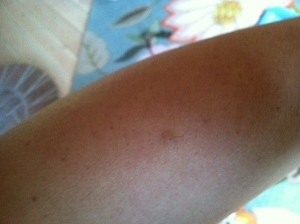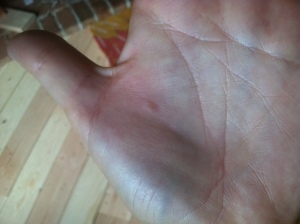This week I spent my writing juices finishing up a little book on transitioning to minimal footwear, but here's some interesting stuff I've been thinking about. I posted a lot of this on Facebook, but for those of you who don't go on Facebook:
1. Honey as a topical antibiotic
"Antibiotics are mostly one active substance, effective against only a narrow spectrum of bacteria. When used alive, these 13 lactic acid bacteria [found in honey] produce the right kind of antimicrobial compounds as needed, depending on the threat. It seems to have worked well for millions of years of protecting bees' health and honey against other harmful microorganisms. However, since store-bought honey doesn't contain the living lactic acid bacteria, many of its unique properties have been lost in recent times", explains Tobias Olofsson.”
Read: Bacteria From Bees Possible Alternative to Antibiotics
P.S.: As mentioned in the article, store-bought honey is dead, so if you’re going to slather it on your body, look for a raw honey source in your area. (Call your local beekeeper in the phonebook)
P.P.S.: It is also entirely possible that the honey bought at the store isn’t actually honey, but I'll let you do your own investigation into this matter.
2. Anti-bacterial soaps:
“We looked at the exposure of pregnant women and their fetuses to triclosan and triclocarban, two of the most commonly used germ-killers in soaps and other everyday products,” says Benny Pycke, Ph.D. “We found triclosan in all of the urine samples from the pregnant women that we screened. We also detected it in about half of the umbilical cord blood samples we took, which means it transfers to fetuses. Triclocarban was also in many of the samples.”
Read: Pregnant Women and Fetuses Exposed to Antibacterial Compounds Face Potential Health Risks
3. Not sitting so much:
As I explain more thoroughly in Move Your DNA, the effects of sitting are just as much on the micro (cellular) level as on the macro.
"CONCLUSION: Three hours of sitting resulted in a significant impairment in shear rate and superficial femoral artery flow mediated dilation. When light activity breaks [5 min at 2mph on a treadmill] were introduced hourly during sitting, the decline in FMD was prevented."
CHALLENGE, today and every day, really: Break up your sitting bouts with a 5 minute walk every hour! The lining of your arteries (and blood flow through your hip creases) will thank you.
Read research: Effect of Prolonged Sitting and Breaks in Sitting Time on Endothelial Function
Here's a nice layperson article on the research: http://www.neomatica.com/2014/09/09/three-short-walks-reverse-harmful-effects-3-hours-prolonged-sitting/
4. Moles and breast cancer:
As a skin-pigmentation nerd, I find these studies fascinating. I have been a long-term investigator into the WHYs of freckles, moles, and skin tags, and have been tracking my own as they form on a preferred side of my body, concentrated in specific areas.
These are two moles, both on my left side, that I've had since being 4 or 5. I once had a palm reader freak out at the mole on the palm of my hand but I don't know if it was a good or bad thing. If you know, let me know would you?
In the case of a mole, or skin cancer, or even in the case of circulating hormones or sun exposure there still needs to be a reason WHY THAT PARTICULAR BODY LOCATION. I'd like to see a geometrical aspect to this and other skin research, plotting moles like constellations to see how they relate to whole-body functions beneath the surface.
Read research press-release: Moles linked to risk for breast cancer
Research articles:
Association between Melanocytic Nevi and Risk of Breast Diseases: The French E3N Prospective Cohort
5. Mechanobiology:
The following link is perhaps the most important bit I’ve read in research in the last couple of years.
http://www.upenn.edu/pennnews/news/penn-nih-team-discover-new-type-cell-movement-3d-matrix
In a nutshell, it turns out that the way cells have been studied—in a 2-D petri dish—has affected their behavior. Compared to when I share stuff like the anti-bacterial soap thing (which got 50,000+ views) it was all crickets when I shared the following on Twitter:
Studying biological organisms in a movement-limited environment leads to conclusions that do not apply to that same organism in their natural and movement-rich habitat. This goes for orcas, humans--and individual cells, as researchers have just "discovered."
The crickets don’t really confuse me; I’m guessing that articles with a clear action step (e.g. stop using anti-bacterial soap immediately) are easy to rally behind, where and article on “turns out so much of what we know about cells was concluded from studies that might have been swayed by how we conducted them” isn’t as action-making. Or maybe the action step is too big. Taking everything you “know” about cells and biology and flagging it as “needs adjustment” is an overwhelming and can mean thousands of action steps. With so much to do, it's amazing how any of us have time to be on Facebook.
Dear Those People Who Don't Go On Facebook,
You are amazing. I aspire to be like you, and I am heading that way, slowly.
xo,
KAB

